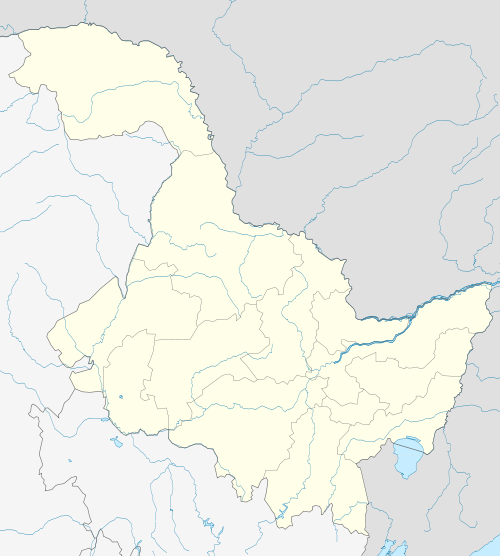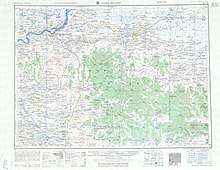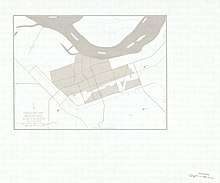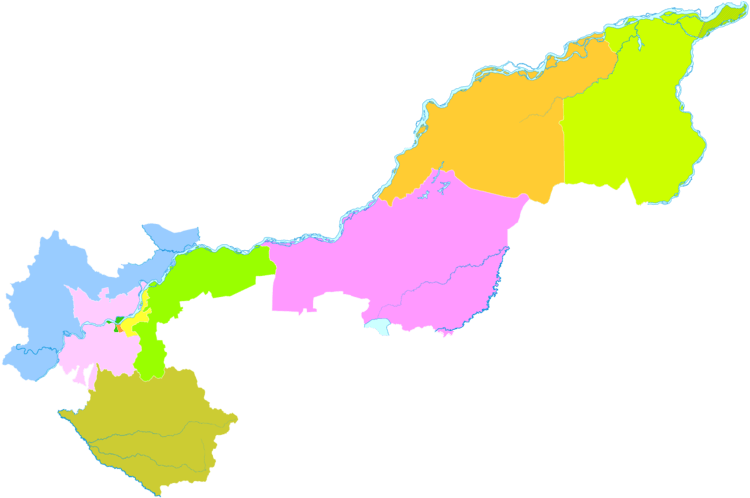Jiamusi
Jiamusi (Chinese: 佳木斯 [ˌtɕiá.mû.sí]; formerly Kiamusze) is a prefecture-level city in eastern Heilongjiang province, People's Republic of China. Located along the middle and lower reaches of the Songhua River, it faces Russia's Khabarovsk Krai across the Ussuri River and the Heilongjiang. In 2018, Jiamusi had a GDP of RMB 101.2 billion with a 4.3% growth rate. Jiamusi had a total population of 2.333 million at the 2018 census, of which 1.24 million lived in the urban area and 1.09 million lived in the rural area.[3]
Jiamusi 佳木斯市 Chia-mu-ssu, Kiamusze | |
|---|---|
 | |
.png) Location of Jiamusi City (yellow) in Heilongjiang (light grey) | |
 Jiamusi Location of the city centre in Heilongjiang | |
| Coordinates (Jiamusi government): 46°48′00″N 130°19′08″E | |
| Country | People's Republic of China |
| Province | Heilongjiang |
| County-level divisions | 10 |
| Government | |
| • Type | Prefecture-level city |
| • Mayor | Shao Guoqiang (邵国强)[1] |
| • Municipal Committee Secretary | Xu Jianguo (徐建国)[2] |
| Area | |
| • Prefecture-level city | 31,528 km2 (12,173 sq mi) |
| • Urban | 882.5 km2 (340.7 sq mi) |
| Elevation | 83 m (271 ft) |
| Population (2018)[3] | |
| • Prefecture-level city | 2,333,311 |
| • Density | 74/km2 (190/sq mi) |
| Time zone | UTC+8 (China Standard) |
| Postal code | 154000 |
| Area code(s) | 0454 |
| ISO 3166 code | CN-HL-08 |
| Licence plates | 黑D |
| Climate | Dwa |
| GDP (nominal) | 2018 |
| - Total | CNY 101.2 Billion (14.6 Billion USD) |
| - Per capita | CNY 43,372 (6,262 USD) |
| Website | www |
| Jiamusi | |||||||
|---|---|---|---|---|---|---|---|
 "Jiamusi", as written in Chinese | |||||||
| Chinese name | |||||||
| Chinese | 佳木斯 | ||||||
| Postal | Kiamusze | ||||||
| |||||||
| Manchu name | |||||||
| Manchu script | ᡤᡳᠶᠠᠮᡠᠰᡳ | ||||||
| Romanization | Giyamusi | ||||||
| Russian name | |||||||
| Russian | Цзямусы | ||||||
History
Early history
In 1720, Jiamusi was first named Giyamusi (ᡤᡳᠶᠠᠮᡠᠰᡳ, 甲母克寺噶珊,嘉木寺) during the Kangxi period by the Nanai people.[4] The word Giyamusi originally means Inn in the Manchu language. Because of the harsh climate and short growing season, the region of today's Jiamusi City was largely uncultivated .
Since the Qing government opened Manchuria for farming in order to prevent the conquest of the area by Russia, Jiamusi developed as a small trading post under the name Dongxing (東興鎮) since 1888.[4] When Han Chinese and Manchu settlers began to move into the area, Jiamusi became the seat of a county administration, under the name Huachuan in 1910. However,the county seat was moved to Haoli (Hegang), which is about 30 miles to the north, after several destructive floods. After Xinhai Revolution, as the Han Chinese went on moving in, the population of Jiamusi rose very rapidly. Jiamusi continued to grow as a commercial center. As Jiamusi has become the largest harbor along the lower reaches of Songhua River, a road system was constructed in order to provide convenient transport linking Jiamusi to several other important strongholds in Northeastern China including Harbin and Nancha.
Japanese occupation period
As the Japanese invasion of Manchuria began, Jiamusi was established as an administrative centre of the puppet Manchukuo government. Going by the name Kiamusze, Jiamusi was also the capital of Sanjiang province. Jiamusi was regarded as an important military strongpoint to defend the Soviet Red Army's possible invasion. In 1937, the City of Jiamusi was established. It also became a major military base. Many settlers came into the area, not only from China but also from Korea and Japan, including the Development Group of Manchuria and Mongolia. [5] After the construction of and Tumen-Jiamusi and Suihua-Jiamusi Railway continuously completed in 1937 and 1940, Jiamusi has become an agricultural products distribution center in Heilongjiang.[6]
People's Republic
After 1949, as Jiamusi was still the transport and communications center of this region, the rapid development of Jiamusi continued. Industries including manufacturing agricultural equipment, mining machinery, fertilizers, plastics, and chemicals were developed. Since one of the biggest paper mills in China was built in 1957, Jiamusi has been a major producer of wood pulp and newsprint. Because of being conveniently connected by air and water to Khabarovsk in the Russian Far East, Jiamusi is also an important harbour for international trade in northeastern China.[7]
Geography

Jiamusi is located in eastern Heilongjiang province. Located at latitude 45° 56′−48° 28′ N and longitude 129° 29′−135° 05' E, containing China' easternmost point, although the urban area of Shuangyashan lies further to the east of Jiamusi. Neighbouring prefectures are:
- Harbin (W)
- Hegang (N)
- Qitaihe (S)
- Shuangyashan (E)
- Yichun (W)
It also borders Russia's Khabarovsk Krai to the east. The average elevation in the prefecture is 85 metres (279 ft), with the terrain primarily consisting of plains. The total area of the prefecture is 31,258 square kilometres (12,069 sq mi). The confluence of the Amur, Songhua and Ussuri River meet in the east of the city. The Sanjiang Plain came into being because of the alluvion of these three large rivers.
Climate
Jiamusi has a monsoon-influenced humid continental climate (Köppen Dwa), with long, bitter, but dry winters, and humid and very warm summers. The monthly 24-hour average temperature ranges from −18.5 °C (−1.3 °F) in January to 22.5 °C (72.5 °F) in July, while the annual mean is 3.62 °C (38.5 °F), and more than 60% of the year's precipitation occurs from June to August. The frost-free period is about 130 days per year, while mean annual precipitation is about 517 mm (20.4 in). Typically, the ground freezes to a depth of 1.2 m (3 ft 11 in), beginning to freeze in late November and beginning to thaw in late March. Extreme temperatures have ranged from −41.1 °C to 38.1 °C.[8]
| Climate data for Jiamusi (1971−2000) | |||||||||||||
|---|---|---|---|---|---|---|---|---|---|---|---|---|---|
| Month | Jan | Feb | Mar | Apr | May | Jun | Jul | Aug | Sep | Oct | Nov | Dec | Year |
| Record high °C (°F) | 1.8 (35.2) |
9.8 (49.6) |
20.2 (68.4) |
29.2 (84.6) |
33.5 (92.3) |
35.4 (95.7) |
38.8 (101.8) |
35.8 (96.4) |
30.8 (87.4) |
26.1 (79.0) |
15.1 (59.2) |
5.0 (41.0) |
38.8 (101.8) |
| Average high °C (°F) | −12.7 (9.1) |
−7.3 (18.9) |
1.5 (34.7) |
12.7 (54.9) |
20.4 (68.7) |
25.0 (77.0) |
27.6 (81.7) |
25.8 (78.4) |
20.1 (68.2) |
11.2 (52.2) |
−0.8 (30.6) |
−10.5 (13.1) |
9.4 (49.0) |
| Daily mean °C (°F) | −18.5 (−1.3) |
−13.9 (7.0) |
−4.3 (24.3) |
6.2 (43.2) |
13.9 (57.0) |
19.3 (66.7) |
22.5 (72.5) |
20.5 (68.9) |
14.0 (57.2) |
5.3 (41.5) |
−6.0 (21.2) |
−15.6 (3.9) |
3.6 (38.5) |
| Average low °C (°F) | −24.0 (−11.2) |
−20.2 (−4.4) |
−10.7 (12.7) |
−0.2 (31.6) |
7.2 (45.0) |
13.9 (57.0) |
17.7 (63.9) |
15.8 (60.4) |
8.3 (46.9) |
−0.2 (31.6) |
−10.8 (12.6) |
−20.4 (−4.7) |
−2.0 (28.5) |
| Record low °C (°F) | −39.5 (−39.1) |
−35.2 (−31.4) |
−35.2 (−31.4) |
−11.9 (10.6) |
−6.0 (21.2) |
3.8 (38.8) |
8.7 (47.7) |
5.4 (41.7) |
−3.2 (26.2) |
−17.0 (1.4) |
−28.4 (−19.1) |
−34.5 (−30.1) |
−39.5 (−39.1) |
| Average precipitation mm (inches) | 3.7 (0.15) |
5.0 (0.20) |
9.4 (0.37) |
21.1 (0.83) |
46.3 (1.82) |
91.4 (3.60) |
104.0 (4.09) |
122.2 (4.81) |
61.4 (2.42) |
33.6 (1.32) |
10.0 (0.39) |
8.4 (0.33) |
516.5 (20.33) |
| Average precipitation days (≥ 0.1 mm) | 5.8 | 5.1 | 5.7 | 7.7 | 11.3 | 13.4 | 12.7 | 13.8 | 11.1 | 8.7 | 5.8 | 7.2 | 108.3 |
| Source: Weather China | |||||||||||||
Subdivisions

On July 26, 2006 Yonghong District (永红区) was merged into Jiao District (郊区).
| Map | ||||||
|---|---|---|---|---|---|---|
| # | Name | Hanzi | Hanyu Pinyin | Population (2010 est.) | Area (km²) | Density (/km²) |
| 1 | Qianjin District | 前进区 | Qiánjìn Qū | 171,530 | 14 | 12,252 |
| 2 | Xiangyang District | 向阳区 | Xiàngyáng Qū | 233,855 | 24 | 9,744 |
| 3 | Dongfeng District | 东风区 | Dōngfēng Qū | 161,740 | 53 | 3,052 |
| 4 | Jiao District | 郊区 | Jiāoqū | 314,586 | 792 | 397 |
| 5 | Tongjiang City | 同江市 | Tóngjiāng Shì | 179,791 | 6,252 | 29 |
| 6 | Fujin City | 富锦市 | Fùjǐn Shì | 437,165 | 8,227 | 53 |
| 10 | Fuyuan City | 抚远市 | Fǔyuǎn Shì | 126,694 | 6,260 | 20 |
| 7 | Huanan County | 桦南县 | Huànán Xiàn | 468,698 | 4,416 | 106 |
| 8 | Huachuan County | 桦川县 | Huàchuān Xiàn | 202,827 | 2,260 | 90 |
| 9 | Tangyuan County | 汤原县 | Tāngyuán Xiàn | 255,211 | 3,230 | 79 |
Sport
Five of the players in the national bandy team at their first World Championships came from Jiamusi. It's one of the cities in which China Bandy Federation explores the potential for further development.
Economy
Jiamusi has long been a major transit port and distribution center of goods, and serves as the economic hub of eastern Heilongjiang province. In 2011, Jiamusi's GDP paced up to RMB 62.53 billion representing a steady growth of 14.2% from a year earlier.[9] In 2015, Jiamusi has a GDP of RMB 81.01 billion.[10]
Jiamusi is an agricultural production hub in Heilongjiang Province. Value-added output from the agricultural sector increased 14.2% to RMB 18.92 billion in 2011. Crop production of the city rose 26.8% to 7.3 million tons. In 2011, gross industrial output from enterprises with designated size or above of the city surpassed RMB 39.34 billion, increased 35.5% year on year. Gross output from heavy industry amounted to RMB 22.77 billion, increasing by 38.7% compared with a year ago, while that from light industry reached RMB 16.57 billion, surging 31.4% from the previous year. Heavy industry and light industry made up 64% and 36% of the city's total gross industrial output.
Electricity production and supply, construction materials, chemicals and agricultural products processing are the pillar industries in the city. Major industrial products in the city include cement, edible oils, fertilizer and feed. The industrial sector in Jiamusi is relatively weak compared with other cities in Heilongjiang such as Harbin and Daqing. In 2011, the service sector became the largest contributor of the city, which gained value-added output of RMB 26.99 billion. This contributes 43.2% to Jiamusi's economy. With the consumer market being very active, sales of consumer goods in Jiamusi amounted to RMB 24.55 billion in 2011, rising 18.2% year on year.
Foreign trade value increased 19.6% to RMB 3.65 billion in 2011. Export value was US$3.01 billion, representing a rise of 6.1% over the previous year. while import value stood at US$640 million, increased 197.5% year on year. Russia is Jiamusi's largest foreign trade partner. In 2011, foreign trade with Russia amounted to US$900 million, increased 24.5% over the previous year, accounting for 24.66% of the city's foreign trade. The utilized FDI in Jiamusi hit US$150 million in 2011, increased 33.5% over the previous year.[4]
Transportation
Railway
Jiamusi is a transportation hub in northeast Heilongjiang. Suijia(Suihua-Jiamusi) Railway and Tujia(Tumen-Jiamusi) Railway meet here. Trains from Jiamusi Railway Station connect the city with Beijing, Jinan, Dalian, Harbin, Tianjin and several other cities in China. On September 30, 2018, the Harbin–Jiamusi intercity railway was opened to passenger traffic, which shortened the travel time between Jiamusi and Harbin from six hours to two and half hours.[11][12]
Highway
Jiamusi is served by the G1011 Harbin-Tongjiang Expressway, the G11 Hegang-Dalian Expressway, as well as six other highways, forming a comprehensive highway network.
Air
Jiamusi Dongjiao Airport is 9 km (5.6 mi) east of the city center, which offers flights to a number of domestic destinations and international destinations such as Khabarovsk[13] and Seoul.[14]
Ports and waterways
First built in 1919, Jiamusi Port is a major port along the downstream of Songhua River. The port was expanded in 1937 and became a Steel-structured-port. However, The annual throughput of the port was less than 120 thousand tons per year until PRC's foundation in 1949. Now the annual throuput was about 1 million tons per year.[8] Available from mid-April until the beginning of November, passenger ships sail from Jiamusi up the Songhua River to Qiqihar, Harbin or downstream to Tongjiang and Khabarovsk in Russia.
Higher education
Jiamusi is home to Jiamusi University.
Twin towns
Domestic
International


.svg.png)


References
- "Mayor's Page" 市长专页. Retrieved 2019-06-17.
- "Secretary's Page" 书记专页. Retrieved 2019-06-17.
- "Statistic of Jiamusi on National economy and social development in 2018" 2018年佳木斯市国民经济和社会发展统计公报. Retrieved 2019-06-17.
- Profiles of China Provinces, Cities and Industrial Parks
- 开拓团:没有枪的殖民者. 163.com news (in Chinese).
- Encyclopædia Britannica:Jiamusi http://www.britannica.com/EBchecked/topic/110111/Jiamusi
- 黑龙江佳木斯市志编纂委员会 (Jiamusi, Heilongjiang City Almanac Compilation Committee) (1996). 佳木斯市志 [History of Jiamusi]. Zhonghua Book Company. ISBN 7-101-01593-X.
- 黑龙江省佳木斯口岸简介. 中国黑龙江信息网. Archived from the original on 2014-01-13. Retrieved 2014-01-13.
- 佳木斯市2011年度GDP突破600亿 [Main economic indicators of Jiamusi City in 2011] (in Chinese). Jiamusi People's Government. Retrieved 2014-01-23.
- http://www.phbang.cn/finance/data/152416.html
- 哈佳铁路开工建设. Harbin.gov.cn (in Chinese). Harbin People's Government. July 3, 2014. Archived from the original on March 4, 2016. Retrieved June 19, 2019.
- 哈佳铁路9月30日开通运营 两地车程缩短至2小时. 中国新闻网.
- "Flight schedule. Aurora Airline". www.flyaurora.ru. Retrieved 2019-06-17.
- 济州航空通航航线 | 济州航空. www.jejuair.net. Retrieved 2019-06-17.
- "List of sister cities of Jiamusi". Retrieved 2019-06-20.
- "International Exchange". List of Affiliation Partners within Prefectures. Council of Local Authorities for International Relations (CLAIR). Archived from the original on 5 February 2016. Retrieved 21 November 2015.
